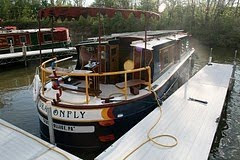Our boat was designed to look like the packet boats that once carried passengers on the Erie Canal. So it's fun to play at being a packet boat. On Tuesday, our friends In Shik and Steve
brought their friends, Sandy and Dru, visiting from Washington, DC, to the
boat for a day cruise.
We’d already done a “best of the Erie
Canal” tour heading west--our cruise to Fairport and Pittsford with Doug and Clare.
Where to go this time? East to Palmyra!
 |
| In Shik, Steve, Sandy, Cap, Dru. On an 1825 canal boat, the side door would have been occupied by a mule! |
 |
| Part of the SlowBoat experience: braving a gauntlet of goozlers at Lock 29 |
At lock 29, the passengers hopped off the boat (and braved a torrential thunderstorm) to see the restored “change bridge.”
Once
common along the canal, these bridges were cleverly designed so a team of mules
could change sides--that is, cross from a towpath on one side of the canal to a
towpath on the OTHER side--without tangling the tow rope around the bridge.
Two Locks are Better than One
For me, the most engaging stop on this
cruise is Old Lock 60. It’s two locks, actually. The
first was built in 1841, when the canal, highly successful after little more
than 15 years in operation, was made wider and deeper.
 |
| "The canal boat goes riiighhtt here . . ." |
These locks are dry today (the canal was widened even more and re-routed again in 1918).
But volunteer groundskeepers from the local
community keep the grass so neatly mowed that, if you squint, you could mistake
the turf for green water.
 |
| Doors go here! |
The locks themselves are made of rectangular
blocks of dark gray limestone, crisply edged, with graceful curved abutments
and charming little steps at the eastern end, leading down to water level.
You
can see the slots where the lock doors once folded back to fit flush with the
walls.
The stonework shows surprisingly little
wear and tear . . . except for the grooves worn into the edges of the lock by tow
ropes, grinding along for decades.
Work Well Done Deserves an Award
The volunteers who keep this lock accessible to visitors were recognized in 2013 with a “Heritage Award” from
the Erie
Canalway National Heritage Corridor. (The Erie Canal is managed by
the New York State Power Authority, but it’s also a National Heritage Corridor, a unit of the National Park Service.)
The awards committee shared this detail:
 |
| Chatting with Bill Lawton (green shirt), volunteer groundskeeper |
Volunteers recalled their early days in the late 1980s when underbrush
on site was so thick that they crawled on hands and knees to find the stone
lock. They removed extensive vegetative growth that covered both the lock and
bridge abutments, cleared and marked trails, installed a dock for boaters, and
added wayfinding and interpretive signs.
Thanks for all you have done to maintain Old Lock 60, folks! We were thrilled to be able to take this trip back in time.
Thanks for all you have done to maintain Old Lock 60, folks! We were thrilled to be able to take this trip back in time.
Queen of the Canal Towns
 |
| The "new" facade of the Phelps Store |
With all of this canal sightseeing, we did finally make it to Palmyra, which refers to itself as the “Queen of the Canal Towns.”
We toured a canalside
general store, where the front door, which originally faced the canal, was relocated to a side street so ladies and
children wouldn’t have to encounter the rough-and tumble “canawlers” when they went
shopping.
We also stopped in the old Depot, where travelers once
purchased tickets to board an Erie Canal packet boat, and where you could trade
in your tired mules for fresh ones.
And through all of this sightseeing on our personal packet boat, Dragonfly’s
solar system kept us gliding along all day at the stately mule-like pace of 4 mph,
no hay or water needed.
 |
| Did the original Erie packet boats let you do this at the end of the day? "High Five! We didn't sink the boat today!" |





No comments:
Post a Comment